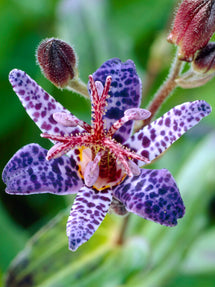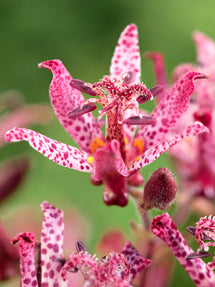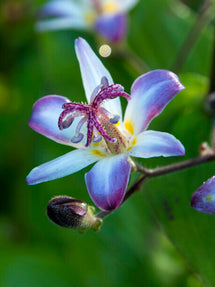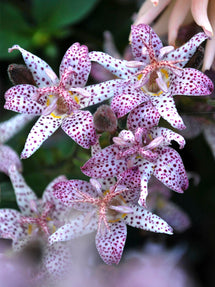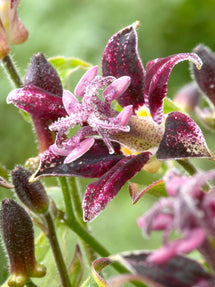Tricyrtis (Toad Lily)
Add Exotic Beauty To Your Garden With The Captivating Toad Lily
Toad Lilies bring something truly rare to your UK garden. These unusual and captivating perennial plants are prized for their exotic-looking, intricate blooms and their preference for shady spots. They make an excellent choice for British gardeners seeking to introduce an element of the extraordinary to their shaded areas. Ideal for quiet corners, beneath tree canopies, or along shadowy borders, Toad Lilies add both colour and texture where it’s often difficult to do so. Explore our collection to discover the variety that best suits your garden.
Showing 1 - 5 in 5 items
Tricyrtis Hirta: A Standout Choice For A Touch Of The Unusual
Toad Lily, botanically known as ‘Tricyrtis Hirta’, belongs to the Lily family (Liliaceae). Native to Northeast Asia, the genus Tricyrtis is celebrated for its distinctive and captivating character. Although the plant has small flowers, they are remarkably detailed. Each flower typically bears 6 showy tepals (similar appearing sepals and petals), creating a whimsical and exotic display above the shrub foliage.
These blooms are often adorned with unique speckles or mottling. Prominent stamens characteristically jut up and out from these petals. The colour palette ranges from creamy white flowers to soft shades of purple, frequently evoking the charm of purple-spotted Phalaenopsis orchids. In addition to these, bicoloured and even tricoloured cultivars are also available, offering further diversity for the discerning gardener.
Hairy Toad Lily
The tall, arching stems bear leaves in a distinctive, ladder-like pattern that adds to the plant's charm. The entire plant is finely haired, lending it the common nickname, the ‘Hairy Toad Lily’. It integrates beautifully into more naturalistic garden settings. While it is generally unappealing to deer, gardeners should note that rabbits may nibble on its leaves and flower buds.
Discover The Captivating Varieties Of Toad Lily
Toad Lilies bloom in a wide array of varieties, each possessing its own distinctive and enchanting appeal. Tricyrtis ‘Golden Gleam’, for example, has golden-like leaves with dark purple and white speckled blooms. Tricyrtis ‘Macropoda’ features white, speckled flowers adorned with deep purple spots and striking burgundy stems. For a more delicate option, consider Tricyrtis ‘Taiwan Adbane’, which displays exotic blue to pale lavender edges surrounding a crisp white centre.
If your garden is in need of late-season colour, from late summer through to mid-autumn, Toad Lilies make an excellent choice. These orchid-like flowers are relatively easy to cultivate, provided their bare roots are planted in suitable conditions. For a truly captivating shade garden in the latter part of the year, consider pairing these perennial blooms with Hostas, Ferns, or Sedums.
How To Plant Toad Lily Bare Roots For Maximum Impact
Every plant has its own requirements, and Toad Lilies are no exception. To enjoy their enchanting blooms in late summer or autumn, plant Toad Lilies in early spring and follow the instructions below.
Select a location with full shade or partial shade. Next, soil preparation. Ensure you use well-drained soil that is rich in organic matter. To help these perennials develop tall, sturdy stems, ensure the soil remains consistently moist. Also, protect the delicate stems with their small clusters of blooms from strong winds. Next, dig a hole wide enough to lay the bare root flat without bending or crowding it. Position the root with the growth tip facing upwards, then gently cover it with soil. Firm the soil around the root to eliminate any air pockets, and water thoroughly. Keep the ground evenly moist while the plant establishes itself. During their first season, Toad Lilies require consistently moist soil to help their roots establish and develop strength. Also, keep the area around young plants free from weeds.
With the right start, your Toad Lilies will grow steadily and reward your efforts with elegant, speckled blooms during the growing season. Looking for more advice? Simply follow our growing guide ‘How to Grow Tricyrtis (Toad Lily)’.
Buy Toad Lily Roots: From Tricyrtis ‘Formosana’ To ‘Raspberry Mousse’
When it comes to achieving the best results, quality is essential. At DutchGrown, we supply premium Toad Lily bare roots, carefully selected for strength, performance and lasting growth. If you’re looking to create a garden with character and distinction, you’ve come to the right place. Whether your preference lies with the rich purple freckles and contrasting yellow throat of Tricyrtis ‘Formosana’, or the dramatic beauty of Tricyrtis ‘Raspberry Mousse’, our collection has something to suit every space and style. Explore our range and discover the perfect Toad Lily for your garden.
Frequently Asked Questions About Toad Lilies
Where Is The Best Place To Plant A Toad Lily?
The ideal location for planting a Toad Lily is in dappled shade, where the soil is consistently moist and rich in nutrients, especially in hotter climates. These hardy perennials flourish in sheltered spots that offer protection from strong winds, helping to preserve their delicate stems and intricate blooms.
Do Toad Lilies Spread?
Toad Lilies are clump-forming perennials that spread gradually over time. They grow in compact clusters and produce upright or arching stems each season. While they won't overwhelm a space, they will slowly expand, making them ideal for naturalistic planting schemes or shaded borders.
Are Toad Lilies Hardy?
Toad Lilies are hardy perennials that return year after year with the optimal growing conditions. With regular care and attention, they remain healthy and continue to thrive, gracing your garden with their distinctive speckled blooms and graceful form. They are particularly well-suited to partially shaded areas, where they offer reliable seasonal beauty.
Is Toad Lily Invasive?
Toad Lilies are not invasive. They spread slowly and form tidy clumps that are easy to manage in most garden settings. While they will gradually expand over time, their growth is well-controlled. With basic care and occasional monitoring, you can easily prevent them from encroaching on neighbouring plants.
